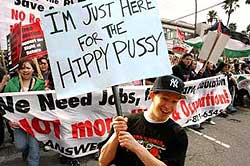Read the whole thing. The usual suspects are trying to burn the city of Sacramento to the ground and trying to make another "Dindo Nuffin" (who, in fact, DID do something) into a martyr.
April 4, 2018
Unwarranted Certainty
The Stephon Clark case is far from unambiguous.April 4, 2018
Public safety
Stephon Clark, holding a cell phone, was shot by police eight times and killed while in the backyard of his grandmother’s house in Sacramento. Black Lives Matter activists have seized on the story as the latest instance of a police war on young black men. But even at this early stage, facts should give us pause before rushing to judgment on the culpability of the officers involved.
Al Sharpton, not unexpectedly, disagrees. While speaking at Clark’s funeral last week, Sharpton said of police, “They have been killing black men all across the country. . . . it’s time to stop this madness.” But it’s far from clear that the officers who shot Clark acted unlawfully, or that the victim’s race played a role in the shooting.
The publicly available evidence is unclear as to whether the police who shot Clark knew of his race at the time, let alone that it influenced their decision to fire. Responding to reports that someone was smashing windows in the neighborhood, the street cops were directed by officers in a surveillance helicopter to Clark’s location. Body cam footage and helicopter video demonstrate that the incident took place in pitch darkness; it was the first night after a new moon, and the only illumination on the scene came from the officers’ flashlights. On the audio of the original 911 complaint, the operator asks the caller “is he black, white, Hispanic, Asian?” The caller responds, “He had a hoodie on. I couldn’t tell, ma’am.” The helicopter video shows that the officers weren’t face-to-face with Clark for more than a few seconds before firing, a period in which their attention was focused on what they apparently believed to be a gun that he was carrying. When the officers made their way up the driveway, Clark turned his back to run away. It wasn’t until he began walking toward officers in the backyard that they might have had an opportunity to see his face.
Most media coverage has pointed out that Clark was unarmed when he was shot. That does not preclude the possibility that officers sincerely (and reasonably) believed he was armed. What the police were thinking matters. Videos of the encounter show police entering the backyard of the house. Upon turning the corner around the back, the lead officer clearly stops short and then retreats behind the side of the house, yelling “Gun!” He pulls his partner backward into a covered position. The two cops then peer around the corner with their weapons drawn, and, from cover, fire ten rounds each, fatally striking Clark, who looked to be walking toward them. That the officers took cover after crossing the threshold into the backyard, and then fired from that position—as opposed to shooting from an exposed position—suggests that they thought Clark was armed. This chain of events weighs against the presumption that their actions were criminal. None of the media coverage has focused on either of these two points, both of which raise the possibility that the two officers (one is black) who shot Clark did so in response to what they reasonably perceived was a threat of deadly force posed by a suspect (race potentially unknown) who had been backed into a corner and was holding an object, mistaken for a gun.
Much has been made about the fact that the officers muted their body cameras after being directed to do so, seemingly by a superior officer, following the shooting. Yet once the shooting happened, the cops were under no legal obligation to make statements on the record without legal representation, given the possibility that they might face prosecution. These protections, codified in the Fifth and Sixth Amendments to the Constitution, are available to everyone, including officers of the law. Moreover, statements made in the immediate wake of a stressful situation can often be unreliable, as a review of relevant literature has shown.
None of this is to say that the two Sacramento police officers who shot Stephon Clark are innocent. But to speak about the March 18 shooting as if it were a clear case of murder, motivated by racial animus, is both unhelpful and unwarranted, given the facts currently available.










